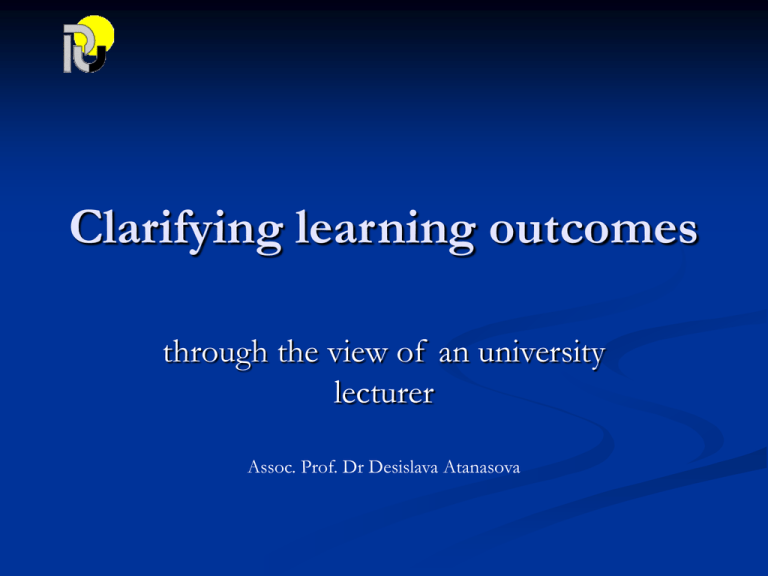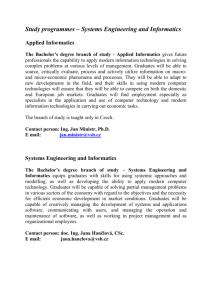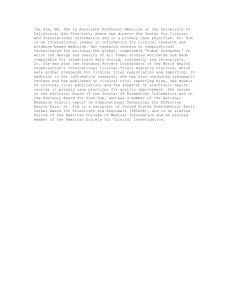What are learning outcomes?
advertisement

Clarifying learning outcomes through the view of an university lecturer Assoc. Prof. Dr Desislava Atanasova Overview What are learning outcomes and why do they matter? Impact of learning outcomes on teaching and learning Learning outcomes application in real programs Be-TWIN: Testing a Joint ECVET-ECTS Implementation 1st WP 2 Meeting 15 & 16.06.2009 2 What are learning outcomes? Learning outcomes are: “statements of what a learner is expected to know, understand and/or do as a result of a learning experience” (ECTS Users’ Guide, 2004) sets of competences, expressing what the student will know, understand or be able to do after completion of a process of learning Be-TWIN: Testing a Joint ECVET-ECTS Implementation 1st WP 2 Meeting 15 & 16.06.2009 3 What are learning outcomes? Learning outcomes are transparent, communicable and assessable; represent a shift from teacher to learner centered: from inputs to outputs; represent one of the essential building blocks for transparency within higher education systems and qualifications; specify the requirements for award of credit. Be-TWIN: Testing a Joint ECVET-ECTS Implementation 1st WP 2 Meeting 15 & 16.06.2009 4 What learning outcomes have to be? The learning activity could be, for example, a lecture, a module or an entire program. Learning outcomes must not simply be a “wish list” of what a student is capable of doing on completion of the learning activity. be simply and clearly described. be capable of being validly assessed. Be-TWIN: Testing a Joint ECVET-ECTS Implementation 1st WP 2 Meeting 15 & 16.06.2009 5 Learning outcomes and competences Learning outcomes have applications in many fields: Programmes, courses Mission statement of the Faculty/university Nationally for qualification framework, quality assuarance Internationally for wider recognition and transparency purposes Be-TWIN: Testing a Joint ECVET-ECTS Implementation 1st WP 2 Meeting 15 & 16.06.2009 6 Why do learning outcomes matter? ECTS, mobility and transparency Pedagogical development Be-TWIN: Testing a Joint ECVET-ECTS Implementation 1st WP 2 Meeting 15 & 16.06.2009 7 Learning outcomes, teaching and learning The reflective practitioner and deep learning The constructive alignment – curriculum; teaching methods; climate of interaction with students; institutional climate; internal rules and procedures. Be-TWIN: Testing a Joint ECVET-ECTS Implementation 1st WP 2 Meeting 15 & 16.06.2009 8 Using learning outcomes More efficient assessment More effective teaching and learning strategies All the advantages of transparency. Be-TWIN: Testing a Joint ECVET-ECTS Implementation 1st WP 2 Meeting 15 & 16.06.2009 9 Purpose of Learning Outcomes Clear to students what’s expected of them Clear to teachers what students are expected to learn in own and other modules Help teachers select most appropriate teaching strategy Helps to keep teaching focused on student learning Help teachers match assessment with curriculum Be-TWIN: Testing a Joint ECVET-ECTS Implementation 1st WP 2 Meeting 15 & 16.06.2009 10 Learning Outcomes approaches Two approaches (by the EUA Quality Culture Project III, Network 4: Teaching and Learning – Implementing Learning Outcomes - Draft) in defining Learning Outcomes: Bottom-Up (recommended); Means defining first LO in the Module level and move upwards to the Program LO involving al stakeholders. Top-Down; Vice-versa. Be-TWIN: Testing a Joint ECVET-ECTS Implementation 1st WP 2 Meeting 15 & 16.06.2009 11 Learning Outcomes architecture. Learning Outcomes should comprise of: The following stakeholders contribute to the debate on the expected learning outcomes: Competences and skills; Knowledge and understanding; Attitudes; Concepts; • Market (Employers) • University teachers • University administration • Students • Social partners (including government as a necessary stakeholder) • Graduates/Alumni • Professional Accreditation Bodies and Associations. Be-TWIN: Testing a Joint ECVET-ECTS Implementation 1st WP 2 Meeting 15 & 16.06.2009 12 Importance of learning outcomes Learning outcomes have applications in many locations: the individual higher education institution (for course units/modules and programmes of study); nationally (for qualifications, qualifications frameworks and quality assurance regimes); and internationally (for wider recognition and transparency purposes). They are important for the understanding of qualifications in society, for example by learners and employers. Be-TWIN: Testing a Joint ECVET-ECTS Implementation 1st WP 2 Meeting 15 & 16.06.2009 13 What is Outcomes Based Education? Outcomes Based Education focuses on student learning by: Using learning outcome statements to make explicit what the student is expected to be able to know, understand or do; Providing learning activities which will help the student to reach these outcomes; Assessing the extent to which the student meets these outcomes through the use of explicit assessment criteria. Be-TWIN: Testing a Joint ECVET-ECTS Implementation 1st WP 2 Meeting 15 & 16.06.2009 14 Outcomes Based Education stages in the backward design process 1 LEARNING OUTCOMES DESIRED RESULTS 2 ASSESSMENT – ACCEPTABLE EVIDENCE 3 LEARNING EXPERIENCES AND INSTRUCTION Be-TWIN: Testing a Joint ECVET-ECTS Implementation 1st WP 2 Meeting 15 & 16.06.2009 15 Outcomes Based Education at the Programme Level The graduate outcomes for a degree are clearly written statements about the knowledge, skills and attitudes of its graduates. Graduate outcomes are developed from a number of sources including professional accreditation bodies, employer groups, the university educational principles and the professional experience of staff teaching in the discipline. Graduate outcomes represent the subject matter, techniques, skills and attitudes of central importance to the chosen discipline(s). From these outcomes the curriculum of the course is constructed, the subdivision of structure into units is made, and the outcomes specific to each of the units are derived. Be-TWIN: Testing a Joint ECVET-ECTS Implementation 1st WP 2 Meeting 15 & 16.06.2009 16 Stages in Learning outcomes Employer meeting Programs from other universities Market research Program Learning Outcomes Be-TWIN: Testing a Joint ECVET-ECTS Implementation 1st WP 2 Meeting 15 & 16.06.2009 17 Stages in Learning outcomes Program Learning Outcomes Curricula for the program Module learning outcomes for each course in the curricula Be-TWIN: Testing a Joint ECVET-ECTS Implementation 1st WP 2 Meeting 15 & 16.06.2009 18 Stages in Learning outcomes Syllabus for each course Main topics of the lectures and seminars Purposes of the workshops and individual assignment Way of teaching Be-TWIN: Testing a Joint ECVET-ECTS Implementation 1st WP 2 Meeting 15 & 16.06.2009 19 Sample Learning Outcomes – Bachelor in Informatics and Information Technologies Bachelors of Informatics and IT will be equipped with professional skills and programming language knowledge in the area of Informatics and IT. Graduates are also provided with good mathematics instruction. The professional qualification is guaranteed by the well-balanced proportion of basic courses in Informatics, Mathematics and other practiceoriented subjects. Be-TWIN: Testing a Joint ECVET-ECTS Implementation 1st WP 2 Meeting 15 & 16.06.2009 20 Sample Learning Outcomes – Bachelor in Informatics and Information Technologies Bachelors of Informatics Technologies will be able to: and Information adjust quickly to any working environment and creatively apply the knowledge gained; analyse the necessity of automation of relevant company activities and suggest adequate software products for the purpose; design and develop or adapt relevant software products for the needs of specific applications, working in teams with other IT professionals of the company; design, implement and administrate computer networks; teach students at high schools if a teaching status has been awarded after relevant facultative courses. Be-TWIN: Testing a Joint ECVET-ECTS Implementation 1st WP 2 Meeting 15 & 16.06.2009 21 Sample Learning Outcomes – Bachelor in Informatics and Information Technologies Course in Operating System Students will be given knowledge and skills about the main principles of design and functioning of the operating systems. They will receive practical skills at the practice sessions, which are based on the two most widespread OS: Windows and UNIX. Be-TWIN: Testing a Joint ECVET-ECTS Implementation 1st WP 2 Meeting 15 & 16.06.2009 22 Implications of learning outcomes Learning outcomes statements are typically characterised by the use of active verbs expressing knowledge, comprehension, application, analysis, synthesis, evaluation, creation etc. They have implications for qualifications, curriculum design, teaching, learning and assessment, as well as quality assurance. Be-TWIN: Testing a Joint ECVET-ECTS Implementation 1st WP 2 Meeting 15 & 16.06.2009 23





